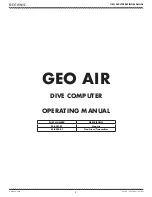
XT2640 Operating Manual
13 July 2016
Page 85 of 187
Note:
You may also manually stop the measurement, and by setting an END level of 0.0W and a START level of 0.0W then
effectively the measurement period will be totally manually controlled.
17.1.3
PERFORMING
A
LOW
POWER
MEASUREMENT
AND
VIEWING
THE
RESULTS
You can START and manually stop a low power measurement by pressing the START button (which is labelled STOP while a
measurement is being performed). This controls low power measurements in all channels within the selected VPA.
Note:
For strict accordance with EN50564:2011 para. 4.3 the voltage source to the device being measured may need to be a
regulated power source with limits on the voltage level and stability, frequency value and stability, voltage crest factor and
voltage distortion. It is possible that the local mains supply meets these requirements, but this is often not the case. Also,
the EN50564:2011 requirements for voltage level and frequency are often overridden by other standards, usually calling
for EN50564:2011 measurement of power and imposing limits on the measurement result, but which are specific to local
supply voltages or frequencies different to those defined in EN50564:2011. The XT2640 maintains a record of the voltage
level, frequency, voltage crest factor and voltage THD during a low power measurement and reports the range of these
measurements encountered during the measurement, and also reports if any of the crest factor or THD requirements are
exceeded by coloring the data red if those EN50564:2011 requirements are exceeded, but the XT2640 does not stop a low
power measurement nor otherwise prevent the user from recording the final measurement result.
You do not have to remain on the STBY POWER screen during the measurement. The measurement will automatically
progress whether this screen is being displayed or not.
The measurement hold capability of the XT2640 is not applied to the STBY POWER results.
The following data is shown in each of the results areas on this screen, listed in order from top to bottom in each area. Except for the
total measurement time, all data is for the last 2/3
rd
of the measurement time if configured for EN50564 5.3.2a method or for the
entire measurement time if configured for the 5.3.2d method. You can select which channel within the selected VPA is being viewed
by using the CH n button (which is labelled according to the presently selected channel). This does not affect measurements, only the
data being displayed.
17.1.3.1
TIME
RESULTS
AREA
1.
The elapsed total time of the low power measurement.
2.
“WAITING” (if waiting for the configured START power level to be exceeded when configured for the 5.3.2d method),
“RUNNING” (when less than the minimum test time), “EXTENDING” (if beyond the minimum test time), if manually stopped
then it shows “STOPPED”, and if automatically completed it shows “COMPLETED”.
3.
The average actual measurement sampling period.
17.1.3.2
POWER
RESULTS
AREA
1.
The average power (in Watts).
2.
The range of power encountered.
3.
The slope of the linear regression in W/hour (only shown if configured for the 5.3.2a method).
17.1.3.3
VOLTS
RESULTS
AREA
1.
The average AC+DC RMS supply voltage.
2.
The range of AC+DC RMS supply voltage encountered.
3.
The range of AC+DC RMS supply frequency encountered.
4.
The highest supply voltage THD (measured over the 2
nd
through 13
th
harmonics) encountered. This is colored RED if this
exceeds the requirements of EN50564:2011 (the screen shown above gives an example of this occurring).
5.
The range of supply voltage crest factor (CF) encountered. This is colored RED if this exceeds the requirements of
EN50564:2011.
















































